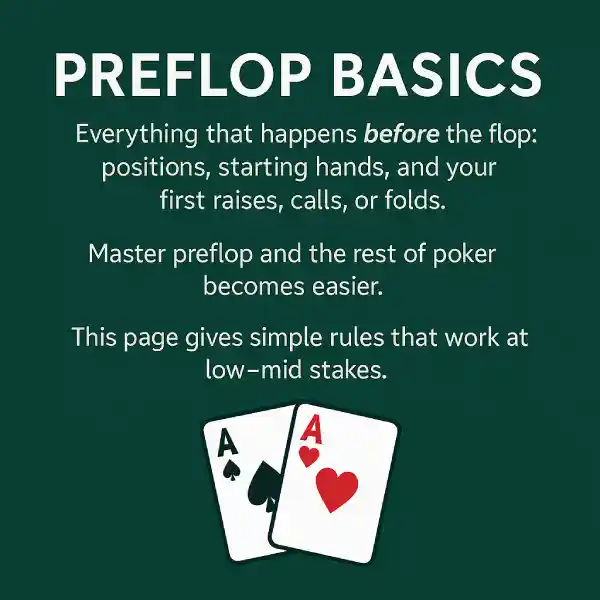What is preflop?
Simple idea
You get 2 hole cards. Before any community cards appear, players act in order. You can fold, call, or raise.
Good preflop = fewer mistakes later. Choose hands that make money, from seats where you act late.
Your goals
- Play stronger hands in early seats, more hands in late seats.
- Use standard sizes so your decisions are repeatable.
- Avoid weak calls out of position.

Positions (who acts when)
Early
UTG / UTG+1 (9-max) or UTG (6-max). Many players act after you → play tight.
Middle
MP. Still some players behind you. Add a few more hands, but stay solid.
Late
Cutoff (CO) and Button (BTN). You act last postflop often → open the most hands.
Blinds
SB and BB. You post money first and play out of position a lot → be careful with calls.
Read more
See the full page: Position — why acting last is powerful.
Open-raising (first raise in pot)
Default sizes
- 2.0–2.5x from most seats.
- Button: 2.0–2.3x (you are in position).
- Small Blind: vs folds, 3x is common (you’ll be OOP).
x = big blinds. Example: 1/2 blinds → 2.2x = 4.4 chips.
Sizing deep-dive: Bet Sizes (Easy Guide).
Starting hand buckets
Premium
AA, KK, QQ, AKs
All seats
Strong
JJ–99, AQs–ATs, KQs, AKo
UTG+ / wider later
Playable
88–66, A9s–A2s, KJs–KTs, QJs, JTs, T9s
MP/CO/BTN
Speculative
55–22, 98s–54s, K9s, QTs
CO/BTN
Trash
Offsuit junk like J4o, T6o
Fold
This is a simple template for full-ring/6-max. Adjust for table quality and stacks.
Facing a raise (your options)
Fold
Best option with weak hands, especially out of position. Folding preflop saves chips.
Call
- Prefer in position (CO/BTN) vs reasonable opens.
- Good with suited broadways, pairs, suited connectors.
- Avoid wide calls in SB (tough postflop).
3-bet (re-raise)
- Value: QQ+, AK, sometimes JJ/AQ.
- Bluff: blockers like A5s, KTs (more on BTN/CO).
- Size: ~3x IP, 3.5–4x OOP.
Simple rule: Out of position, play tighter and 3-bet more of your playable hands. In position, call more and 3-bet a mix of value + blockers.
3-bets & 4-bets (quick plan)
3-bet ranges (starter)
- Value: QQ+, AK (always). Add JJ/AQ vs loose opens.
- Bluffs: A5s–A2s, KTs–KQs, QJs (best on BTN/CO).
- Sizes: ~3x IP; 3.5–4x OOP (vs 2.2x open → 6.5–7x IP, 8–9x OOP).
4-bet ranges (starter)
- Value: KK+, AKo/AKs (often). QQ some of the time.
- Bluffs: A5s/A4s (blockers, good equity when called).
- Sizes: Not all-in: ~2.2–2.5x IP, 2.5–2.8x OOP (of the 3-bet size).
Shorter stacks → more all-ins (see below).
Versus limpers (no raise yet)
Isolate (raise bigger)
- Rule: 4–5x + 1x per limper.
- Choose hands that play well heads-up: broadways, suited aces, pairs.
- Prefer position (CO/BTN) for isolation raises.
Over-limp (just call)
- Multiway hands: small pairs (set mine), suited connectors, suited gappers.
- Good when many limpers and you are in late position.
Stack sizes (change your plan)
Short (≤ 25bb)
- Open smaller (2.0–2.2x). Fewer calls OOP.
- More shove/fold spots vs 3-bets and late-stage tournaments.
- Pairs & big aces go up in value.
Medium (25–60bb)
- Standard opens (2.0–2.5x).
- 3-bet sizes normal; avoid loose calls OOP.
- Speculative suited hands fine in position.
Deep (60bb+)
- Suited connectors/gappers gain value.
- Be cautious bloating pots OOP with weak top pairs.
- 3-bet a bit larger OOP to deny good odds.
Multiway pots (3+ players)
What changes
- You need stronger hands to continue.
- Position is even more important.
- Bluffs go down; value hands go up.
Preflop tips
- Call more with hands that flop big (sets/straights/flushes).
- 3-bet for value; avoid thin 3-bet bluffs vs multiple callers.
Quick math & examples
Pot odds (facing a raise)
Open size
BBs you call
Pot after call
Price
Your hand should realize enough equity at your position to justify the call. OOP calls realize less.
Example decisions
- BTN vs CO open 2.2x: Call KJs/QTs/98s; 3-bet AK/AQ/QQ+; mix A5s as bluff.
- SB vs BTN open 2.3x: 3-bet more (OOP): AQ/TT+ for value; A5s/KTs as bluffs. Tighten flat-calls.
- BB vs small open + caller: Great price → defend suited connectors, pairs, suited aces.
Blockers? Hands with an Ace/King reduce the chance your opponent has a premium → good 3-bet bluffs: A5s–A2s, KTs–KQs.
Common preflop mistakes
- Calling too much out of position (hard postflop spots).
- Random raise sizes each hand (no plan). Use stable sizes.
- Ignoring position (opening too wide UTG, too tight on BTN).
- Small 3-bets OOP (gives cheap calls). Go 3.5–4x.
- Never 3-bet bluffing on BTN/CO (you lose easy folds).
- Isolating limpers too small (they all come along).
Information only. We do not run games or accept bets. Play safe and within your limits (25+ in Uganda).
